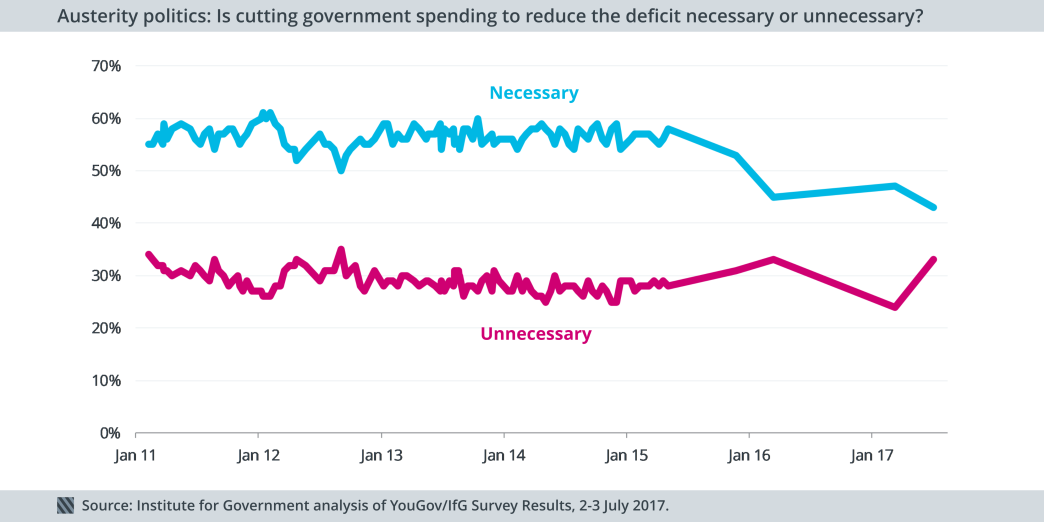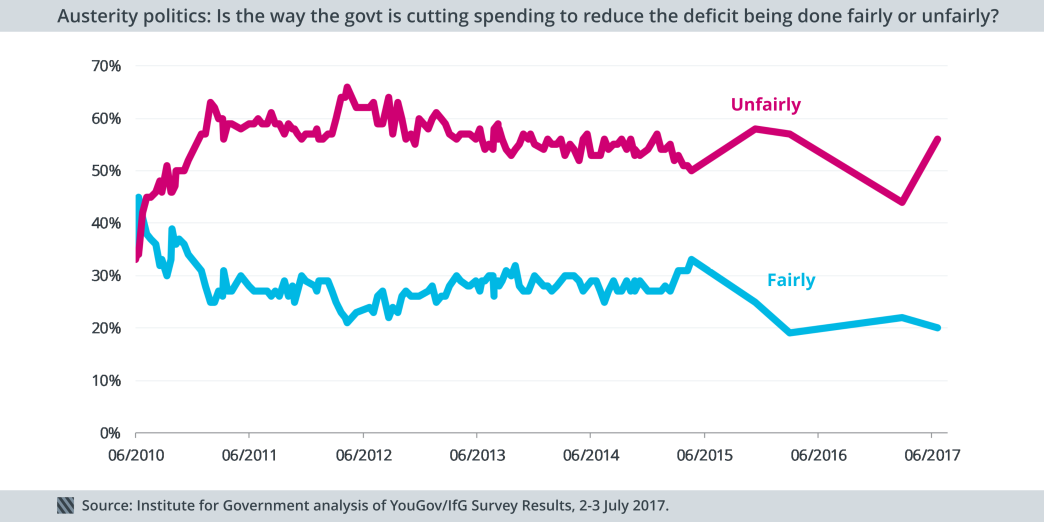The Government does not have a strategy for dealing with the UK’s public finance problems, which are not going away. Julian McCrae says Cabinet must urgently decide if it will revive George Osborne’s “austerity politics”.
The UK is only in the middle of sorting out its public finance problems. Both history and international experience shows that countries with fiscal problems – like those experienced in the UK in the late 2000s – usually take over a decade to resolve them. It is therefore no surprise that the UK is still running a structural deficit when there is no “output gap” (room to expand the economy without provoking inflation) left in the economy, and with a debt level of over 80%.
There are three P's in my argument: Politics, planning and performance.
Politics: The Cabinet needs to decide on a strategy
George Osborne created “austerity politics” in 2010, built around a sense that difficult and unpopular action was necessary in the national interest and that all parts of society would contribute (his “all in it together” line). For the whole of the 2010-2015 Parliament, polling consistently found that for every two people who agreed that cutting spending to reduce the deficit was necessary, only one person thought it was unnecessary.

But that gap has fallen dramatically in the last two years. New polling for the Institute for Government (IfG) finds that 43% of people believe spending cuts are necessary, compared to 33% who believe they are not.
Similarly, this latest polling shows that a growing number of people believe the Government’s approach to spending cuts is unfair as opposed to fair (20% versus 56%).

While these numbers are bad, they also suggest there is scope to revive austerity politics, should the Cabinet decide it wants to make that argument. People still believe spending cuts are necessary. And the gap between those thinking it unfair versus fair is smaller (just) than after Osborne’s 2012 omnishambles budget.
The Cabinet needs to make a choice about its strategy. But whatever happens, it cannot repeat the debacle of the last few weeks, with cabinet ministers contradicting each other over public sector pay.
Planning: The Chancellor needs to hold a mini-Spending Review
Unless the Chancellor decides to attempt to tough it out, sticking to increasingly outdated spending plans, we expect him to hold a mini-spending review in the Autumn.
The 2015 Spending Review was based on the doubling down on its 2010 predecessor, with protected budgets for health, education and international aid, and deeper cuts to budgets for justice, transport and local government.
He now needs to revise these departmental budgets. Obviously, he will need to do so if the Cabinet decides on a new political strategy. But there are also significant pressures emerging in public services. Our Performance Tracker, produced in partnership with the Chartered Institute of Public Finance and Accountancy (CIPFA), shows many essential public services are being pushed to breaking point, and in the case of prisons, beyond it.
Departments also need to start implementing post-Brexit regimes in areas like immigration, customs and farming support. Some of the departments affected, such as Defra, fared badly in the 2015 Spending Review. It is important that, given all the other risks inherent in Brexit, the Treasury does not add to this by being unclear where the money to implement the new regimes will come from.
Performance: The Government needs a new approach to efficiency
Beyond the politics and the planning, the Government needs a new approach to improving efficiency. In the words of Liz Truss, the new Chief Secretary to the Treasury, this is about making “make sure every pound the government spends is improving people’s lives as much as it can”.
Whitehall is struggling to implement the 2015 Spending Review. It has already revisited spending on prisons and social care in response to perceived crises in these areas. The evidence seems clear – the approach to generating efficiency that worked in 2010 have run out of steam, and new a approach is needed.
The outline of this new approach is clear:
1. It will require greater engagement with the public. For example, any plans to transform the health system must be designed and perceived as ways to improve healthcare, rather than to just cut costs.
2. It will need to be driven by the professional workforces found across our public services. Programmes like NHS Getting it Right First Time show how this can be done.
3. Whitehall needs to develop much better data on where the problems (and potential for improvement) lie, to become much more effective in communicating this to the public, and to work constructively to design and implement any improvements.
As the new Parliament starts, it is a good time to take stock of how things have gone and what more needs to happen. This covers the politics of undertaking a fiscal consolidation, the planning necessary to move forward, and how to ensure that the performance of the public sector lives up to the promises made.
Crucially, the Government urgently needs a new approach to improving efficiency, and the Chancellor should start by holding a mini-spending review in the autumn.
Watch an animation of my full presentation at today's IfG event here:
Watch our ‘What next for tax and public spend’ event with the IFS.
- Supporting document
- Performance Tracker final web.pdf (PDF, 976.99 KB)